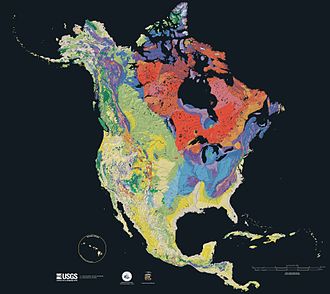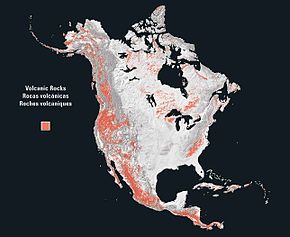Geology of North America




The geology of North America is a subject of regional geology and covers the North American continent, the third-largest in the world. Geologic units and processes are investigated on a large scale to reach a synthesized picture of the geological development of the continent.
The divisions of regional geology are drawn in different ways, but are usually outlined by a common geologic history, geographic vicinity or political boundaries. The regional geology of
North American Craton
The stable core of the continent is the
Canadian Shield

The Canadian Shield is a large area of Archean through Proterozoic igneous and metamorphic rocks in eastern Canada and north central and northeastern United States.
The earliest part of the shield is metamorphosed Archean rocks, originally volcanic in origin. Numerous terranes were accreted onto this Archean core during the Proterozoic to form the Canadian Shield.[4] The southern Archean province is the Superior Craton, it is formed by the combination of a greenstone-granite and a gneiss terrane.[5] The margins of the Canadian Shield have been covered by sedimentary rocks, such as in Michigan where a series of sediments has filled in the Michigan Basin.[4] The exposed sections are often where glaciers have removed this overlying regolith to reveal the underlying glacially scarred crystalline rock.[6]
Stable platform
The stable platform is an area in which the
Midcontinent rift system
One billion years ago, the Midcontinent Rift System began to extend along a 2,000 kilometres (1,200 mi) path,[10] across both the Canadian Shield and the Stable Platform. The rift failed, then crustal movement reversed. A range formed then eroded, forming basins on either side of a horst. These rocks have been buried beneath sediment in many areas, but are exposed in some areas, especially around Lake Superior.[11]
Grenville Orogen
The
Appalachian Orogen

The
Piedmont
The eastern portion of the orogen is made up of the Piedmont plateau, a 150 to 300 metres (490 to 980 ft) elevation area composed of Paleozoic marine and volcanic sediments deformed into crystalline metamorphic rocks and intruded by granite domes.[21]
During the Proterozoic a series of terranes were accreted onto the North American craton, forming the Piedmont of the central Appalachians.
Passive Margin
As the Atlantic Ocean opened the Atlantic Coast turned from an active margin into a passive one. Terranes were no longer accreted onto the margin; instead, sediment eroded off the Appalachians began to be deposited on the coast, forming a coastal plain and continental shelf.[23] During the Jurassic and Triassic, marine and other sediment was deposited to form the Atlantic coastline.[25] The sediment has formed a clastic wedge making up most of the coastal plain and continental shelf.[23]
The passive margin of the
The passive margin in eastern Mexico is made up of a series of basins. These basins are mostly
The
North American Cordillera

The
A rupture in
Rocky Mountains
The Rocky Mountains were formed by a series of events, the last of which is the
The lithology of the Rocky Mountains in western Canada includes a
The Colorado Plateau is a stable region dating back at least 600 million years. As a relative lowland, it had been a site of deposition for sediments eroded from surrounding mountain regions.[38] Then, during the Laramide Orogeny, the entire plateau was uplifted until about six million years ago. Erosion during and following the uplift removed sediment from the plateau. This load removal resulted in isostatic uplift and a second passive rise for the plateau.[39]
Intermontane Province

Between the Rocky Mountains and the coast ranges is an area dominated by extensional forces. The extension of this region has occurred both regionally and locally in events beginning in the Jurassic; however, most extension was localized until the mid Miocene. These local events occurred in the Jurassic, late Cretaceous, and one spanning from the Eocene until the Oligocene. Regional extension occurred during the middle of the Miocene from around 20 million years ago until 10 million years ago.[40]
The Basin and Range Province is a series of linear
Coast
On the West coast of North America, the coast ranges and the coastal plain form the margin, which is partially bounded by the San Andreas Fault, a transform boundary of the Pacific Plate. Most of the land is made of terranes that have been accreted onto the margin. In the north, the insular belt is an accreted terrane, forming the margin. This belt extends from the Wrangellia Terrane in Alaska to the Chilliwack group of Canada.[32]
The timing of the accretion of the insular belt is uncertain, although the closure did not occur until at least 115 million years ago.
Southern Cordillera
The Sierra Madre mountain ranges of Mexico are separated by the Mexican Plateau, and transected by the Trans-Mexican Volcanic Belt. The Southern extent of the American Cordillera makes up Western Mexico and northern Central America.[44] This includes the Sierra Madre Occidental, the Sierra Madre del Sur, and the Trans-Mexican Volcanic Belt.
The Cordillera ends in the south in a belt of
See also
- Geology of North America
- Geology of Canada
- Geology of the Caribbean
- Geology of Central America
- Geology of Belize
- Geology of Greenland
- Geology of the Lucayan Archipelago
- Geology of Mexico
- Geology of the United States
- Geography of North America
- List of mountain peaks of North America
References
- ISBN 9780813752129.
- ISBN 978-3-443-11017-8.
- ISBN 9780716739074.
- ^ a b "The Precambrian Era". Michigan State University. Retrieved 10 Mar 2013.
- ^ Precambrian Geology of the Southern Canadian Shield and the Eastern Baltic Shield (PDF). USA-USSR-Canada Joint Seminar. Minnesota Geological Survey. 21–23 August 1990. Archived from the original (PDF) on 2013-12-03. Retrieved 10 Mar 2013.
- ^ Larson, Phillip (2008). Quantification of Glacial Sediment Erosion, Entrainment, and Transport Processes and Their Implications for the Dynamic History of the Laurentide Ice Sheet (PDF) (Ph.D.). University of Minnesota. Archived from the original (PDF) on 2013-12-03.
- ^ a b c Hamblin, W. Kenneth; Christiansen, Eric (2009). "23". Earth's Dynamic Systems (Web Edition 1.0 ed.). Retrieved 1 Mar 2013.
- ^ Trimble, Donald (1980). "The Geologic Story of the Great Plains". Geological Survey Bulletin 1493. Archived from the original on 2013-03-20. Retrieved 11 Mar 2013.
- ISBN 9780123978066. Retrieved 15 Mar 2013.
- ^ Bornhorst; Woodruff; Nicholson. "Stratigraphy, Structure, and Ore Deposits of the Southern Limb of the Midcontinent Rift System". Retrieved 14 April 2013.
- ^ Anderson, Raymond (1997). "The Midcontinent Rift: Iowa's Almost Ocean". Iowa Department of Natural Resources. Archived from the original on 1999-04-17. Retrieved 5 Mar 2013.
- ^ "The Grenville".
- ^ ISBN 0813711975
- ^ Thomas, William (1973). "Southwestern Appalachian Structural System Beneath the Gulf Coastal Plain" (PDF). American Journal of Science. 273: 372–390. Retrieved 5 Mar 2013.
- , retrieved 5 Mar 2013
- ^ Robert D. Leighty (August 31, 2001), "5.1.2 Valley and Ridge Physiographic Province", Automated IFSAR Terrain Analysis System (Final Report), US Army Aviation and Missile Command, archived from the original on June 26, 2013, retrieved May 9, 2013
- . Retrieved 14 April 2013.
- ISBN 9780813711973, retrieved 8 Mar 2013
- . Retrieved 8 Mar 2013.
- ^ Tagg, John P. "Building the Appalachian Mountains". Archived from the original on 19 September 2014. Retrieved 5 May 2013.
- ^ Aber, James (2001). "Appalachian Mountains". Archived from the original on 18 May 2013. Retrieved 5 Mar 2013.
- ^ Drake, Avery; Brezinski, David; Wintsch, Robert; Kunk, Michael; Aleinkoff, John; Naeser (2006). "Central Appalachian Piedmont and Blue Ridge tectonic transect, Potomac River corridor" (PDF). Geological Society of America. Archived from the original (PDF) on 2013-02-18. Retrieved 10 Mar 2013.
- ^ a b c Stoffer, Phil; Messina, Paula (1996). "The Atlantic Coastal Plain". Retrieved 10 Mar 2013.
- ^ Geology of the Southern Appalachian Mountains (Map). USGS. Retrieved 5 Mar 2013.
- ^ Hanner, Charlie; Davis, Susan; Brewer, James (2006). "Central Appalachian Piedmont and Blue Ridge tectonic transect, Potomac River corridor" (PDF). USDA Resources Conservation Service. Archived from the original (PDF) on 2012-10-21. Retrieved 10 Mar 2013.
- ^ Grubb, Hayes; Carillo, J. Joel. (1988). "Chapter 26: Region 23, Gulf of Mexico Coastal Plain". In Back, William; Rosenshein, Joseph; Seaber, Paul (eds.). The Geology of North America. The Geological Society of America. pp. 219–228. Retrieved 28 Feb 2013.
- doi:10.1306/08130808046. Archived from the originalon 21 April 2014. Retrieved 28 Feb 2013.
- ^ Humapa. 2012. Archived from the original on 4 March 2016. Retrieved 27 Jan 2013.
- hdl:1911/16657.
- ^ Hickman, Robert; Cuervo, Arturo; Valdivieso, Victor; Caraveo, Carlos; Rivera, Sergio; Espinoza, Miguel; Cuevas, Marie; Ghosh, Santosh; Kroener, Robert; Marrullier, Carl (Oct 2002). "Geology and Exploration Potential of the Veracruz Basin". Houston Geological Society Bulletin. 45 (2): 15, 17.
- ^ "A Condensed Geological Chronicle of the Yucatan Platform". Retrieved 17 January 2013.
- ^ a b c d Townsend, Catherine; Figge, John (2002). "Northwest Origins". The Burke Museum.
- doi:10.1016/j.tecto.2009.03.017. Archived from the original(PDF) on 26 November 2013. Retrieved 19 April 2013.
- doi:10.1016/s0040-1951(01)00173-1. Archived from the original(PDF) on 3 March 2016. Retrieved 19 April 2013.
- ^ English, Joseph; Johnston, Stephen; Wang, Kelin. "Thermal modelling of the Laramide orogeny" (PDF). Archived from the original (PDF) on 2013-12-03. Retrieved 2013-03-01.
{{cite journal}}: Cite journal requires|journal=(help) - S2CID 4405770.
- ^ McMechan, Margot; Macey, Elizabeth. Geology of the Rocky Mountains west of Calgary, Alberta in the Kananaskis west half map area (PDF). GeoConvention 2012:Vision. Archived from the original (PDF) on 6 June 2014. Retrieved 15 May 2013.
- ^ Foos, Annabelle. "Geology of the Colorado Plateau" (PDF). Retrieved 5 March 2013.
- ISBN 978-0816064359.
- ^ Gans, Phillip; Miller, Elizabeth (1993). "Extension of the Basin and Range Province". Retrieved 15 Mar 2013.
- ^ "Geologic Provinces of the United States:Basin and Range Province". US Department of the Interior. 13 Jan 2004. Archived from the original on 25 January 2009. Retrieved 15 Mar 2013.
- ^ doi:10.1146/annurev.earth.32.101802.120257. Archived from the original(PDF) on 4 January 2014. Retrieved 9 April 2013.
- ^ Humphreys, Eugene (2009). "Relation of flat subduction to magmatism and deformation in the Western United States". GSA.
{{cite journal}}: Cite journal requires|journal=(help) - ^ a b King, Philip (1969). The Tectonics of North America (PDF). USGS Professional Paper 628. p. 49.
Further reading
- Bally, Albert W. (1989). Allison R. Palmer (ed.). The geology of North America: An Overview. Boulder, Colo.: Geological Society of America. p. 629. ISBN 978-0813752075.
- Clark, Thomas H.; Colin W. Stearn (1968). Geological Evolution of North America (2nd ed.). Ronald Press. ISBN 978-0826020154.
- King, Philip B. (1977). The evolution of North America (Revised ed.). Princeton, N.J.: Princeton University Press. ISBN 978-0691023595.
- McPhee, John A. (1998). Annals of the Former World (first ed.). New York, New York: Farrar, Straus, and Giroux. ISBN 0-374-10520-0.
- Petersen, Morris S.; J. Keith Rigby; Lehi F. Hintze (1980). Historical geology of North America (2d. ed.). Dubuque, Iowa: W. C. Brown Co. ISBN 978-0697050625.

